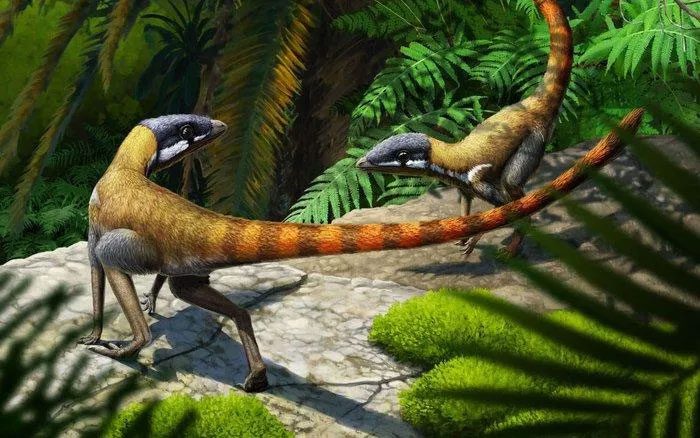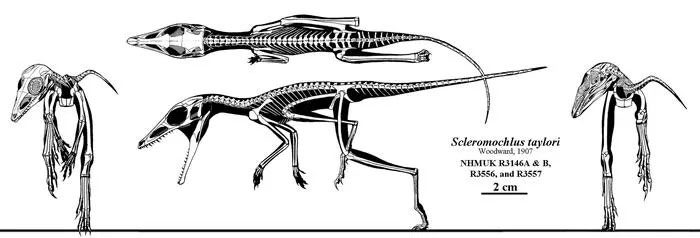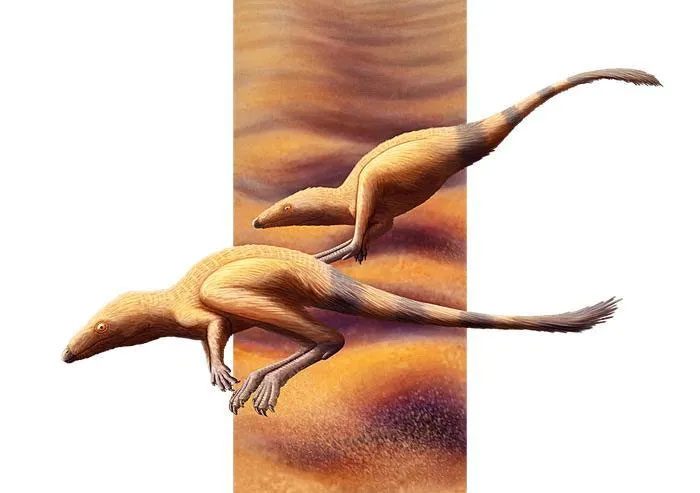Paleontologists have accurately reconstructed the first skeleton of Scleromochlus taylori, a small reptile that lived during the Triassic period, approximately 230 million years ago. Their findings reveal new anatomical details that identify Scleromochlus taylori as a close relative of pterosaurs.
Pterosaurs, the first vertebrates to evolve the ability to fly, were a crucial component of terrestrial ecosystems during the Mesozoic era, thriving from their sudden appearance in the late Triassic until their extinction at the end of the Cretaceous period.
However, the origins and early evolution of pterosaurs remain poorly understood due to a significant gap between this reptile and its closest relatives, the Lagerpetidae.
Scleromochlus taylori, a small reptile from the late Triassic of Scotland discovered over a century ago, has been hypothesized to be an important species closely related to pterosaurs.
This ancient creature belongs to Pterosauromorpha, a group that includes Lagerpetidae and pterosaurs.

Birds, bats, and pterosaurs are not primitive reptiles; instead, they are close relatives of dinosaurs that evolved on a separate branch of the reptile family tree. They were also the first animals, after insects, to develop powered flight—not just jumping or gliding but flapping their wings to generate lift and maneuver in the air. They evolved into dozens of species, some as large as F-16 fighter jets and others as small as paper airplanes.
Dr. Davide Foffa, a paleontologist at the University of Birmingham, and his colleagues stated: “Living around 240-210 million years ago, Lagerpetidae were a group of relatively small reptiles (about the size of a cat or small dog).”
“Scleromochlus taylori is smaller, measuring less than 20 cm (7.9 inches) in length.”
“Our findings support the hypothesis that the first flying reptiles evolved from small, bipedal ancestors.”

Scientists have long debated where pterosaurs fit on the evolutionary tree. The leading hypothesis today suggests that pterosaurs, dinosaurs, and crocodiles are closely related and belong to a group known as Archosaurs. Pterosaurs were an incredibly successful group of reptiles, thriving throughout the age of dinosaurs for over 150 million years. Over time, the earliest pterosaurs—relatively small flying reptiles with robust bodies and long tails—diversified into many different species. Some had long, slender jaws, complex crests, or unique teeth, while others were enormous.
There has previously been disagreement about whether Scleromochlus taylori represents an evolutionary step towards pterosaurs, dinosaurs, or some other branch of reptiles.
In fact, the fossils of this species were poorly preserved in a block of sandstone, making it difficult to study the details necessary to accurately determine its anatomical features.
“It is exciting to resolve a debate that has lasted for over a century, but it is even more remarkable to see and understand an animal that lived 230 million years ago and its relationship to the first flying animals on our planet,” Dr. Foffa remarked.

About 66 million years ago, at the same time that Tyrannosaurus rex and other large dinosaurs went extinct, pterosaurs also perished. Pterosaurs left no descendants—only fossils. However, there are not many fossils, especially compared to their dinosaur relatives. Very few pterosaurs lived near areas conducive to fossilization. Their fragile bones were poorly preserved, so pterosaur fossils are often incomplete. To form a picture of a specific species, paleontologists often have to gather information from multiple fossils or draw conclusions from better-known related pterosaur species.
“This is another discovery that highlights Scotland’s important position in the global fossil record and demonstrates the significance of collections of such specimens held by museums, allowing us to use new techniques and technologies to continue learning and researching these ancient creatures,” he added.
Professor Sterling Nesbitt of Virginia Tech stated: “Pterosaurs were the first vertebrates to evolve the ability to fly, and for nearly two centuries, we did not know what their closest relatives were.”
“Now we can begin to fill in their evolutionary history with the discovery of these tiny close relatives, enhancing our understanding of how they lived and where they came from.”

Scleromochlus (from Greek meaning “hard point”) is a genus of small, extinct Pterosauromorph archosaurs from the late Triassic. This genus contains the type and only species Scleromochlus taylori, named by Arthur Smith Woodward in 1907. Scleromochlus taylori measures approximately 181 mm (7.1 in), with long hind legs; it may have been capable of moving both on four legs and two legs. Studies of its gait suggest that it engaged in a kangaroo-like hopping behavior—or like a spring-loaded tree; if Scleromochlus is indeed related to pterosaurs, this could provide insights into how the latter evolved, as early pterosaurs also exhibited adaptations for saltatorial movement.


















































